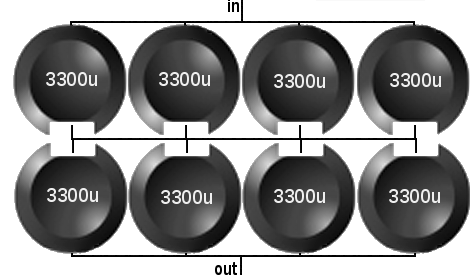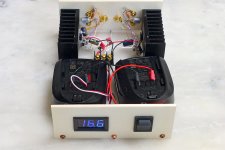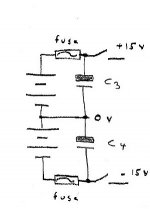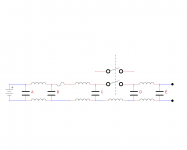In series to the speaker negative:

That blocks DC.
Be sure to see the LM1875 datasheet chapter on stability, most especially the + output inductor||resistor series element.
There's more fun to be had. First off, bypass the big cap board with a 4.7uF bipolar or non-polar cap for intact quality of high frequencies. Secondly, size the big caps corresponding to the capacity of your speaker, so as to cause a roll-off precisely where the speaker begins to lose capacity, thus causing variable current drive bass extension.
That circuit is really ugly to look at, and not economical. However, the thing really rocks when sized to a given speaker.
A good locale for this is at the speaker cabinet, so that the amplifier drives first some cable.
This filter is most often seen with subwoofers, for increased efficiency (reduced load at pitches lower than capacity); however, it can be used with Any size speaker.
As an unintended effect, by removing unnecessary loading of the amplifier for pitches the speaker couldn't do, there is less load to drive, so the batteries may last slightly longer.
P.S.
Also, this is useful to protect lab and concert speakers too.

That blocks DC.
Be sure to see the LM1875 datasheet chapter on stability, most especially the + output inductor||resistor series element.
There's more fun to be had. First off, bypass the big cap board with a 4.7uF bipolar or non-polar cap for intact quality of high frequencies. Secondly, size the big caps corresponding to the capacity of your speaker, so as to cause a roll-off precisely where the speaker begins to lose capacity, thus causing variable current drive bass extension.
That circuit is really ugly to look at, and not economical. However, the thing really rocks when sized to a given speaker.
A good locale for this is at the speaker cabinet, so that the amplifier drives first some cable.
This filter is most often seen with subwoofers, for increased efficiency (reduced load at pitches lower than capacity); however, it can be used with Any size speaker.
As an unintended effect, by removing unnecessary loading of the amplifier for pitches the speaker couldn't do, there is less load to drive, so the batteries may last slightly longer.
P.S.
Also, this is useful to protect lab and concert speakers too.
Yes, I stop music and disconnect amp 😡That can make enough DC offset to burn a speaker.
Thank's for tip, but it's need 2x8x3300 uF (26400 uF) and like you said "not economical".
6x4700 uF give 28200 uF, good enough ?
I'll look for cheap cap.
Phil.
Series parallel (4 of) 6800uF 25v caps may be less expensive.
Depending on the size of the speaker, less capacitance could be used.
For example, just one 1500uF 25v Bi-Polar cap can protect an 8 ohm 4" woofer (and some but not all 5" woofers too).
A different option, is a rail splitter circuit, so as to keep the 0v at the proper centerpoint even if the batteries go lopsided.
Depending on the size of the speaker, less capacitance could be used.
For example, just one 1500uF 25v Bi-Polar cap can protect an 8 ohm 4" woofer (and some but not all 5" woofers too).
A different option, is a rail splitter circuit, so as to keep the 0v at the proper centerpoint even if the batteries go lopsided.
for DC blocking apps Xc<< Xsp
Xc=1/(2*PI*F*C) and Xp is speaker imped. vs frequency see driver data sheet.
so roughly a 4 ohm speaker takes double the C of an 8 ohm driver.
also at low frequency the resonance of the drivers rises, helping low frequency extension.
use speaker impedance Xsp ~ Re (on driver data sheet) at frequencies around 100-200 Hz gives good results. 4,700 uF is a typical value used for 4 ohms, 2,200 uf for 8 ohms.
If you wanna use a blocking cap , may as well be looking at using single supply Vcc topologies. then the cap is bias at 1/2 Vcc and then non-polars aren't necessary.
Xc=1/(2*PI*F*C) and Xp is speaker imped. vs frequency see driver data sheet.
so roughly a 4 ohm speaker takes double the C of an 8 ohm driver.
also at low frequency the resonance of the drivers rises, helping low frequency extension.
use speaker impedance Xsp ~ Re (on driver data sheet) at frequencies around 100-200 Hz gives good results. 4,700 uF is a typical value used for 4 ohms, 2,200 uf for 8 ohms.
If you wanna use a blocking cap , may as well be looking at using single supply Vcc topologies. then the cap is bias at 1/2 Vcc and then non-polars aren't necessary.
Hi guys,
Thank's..
In fact it's like a 6 db HP near 1 hz..
Maybe rail splitter is a good way, it's fix equal voltage, I'll watch it..
Another comment about potentiometer, I try 10 K, but it seems 27 K was better, what is the right value for LM1875 in my case ?
Phil.
I received new Li Ion bat, better sounding than NiCd, much clear..
Thank's..
In fact it's like a 6 db HP near 1 hz..
Maybe rail splitter is a good way, it's fix equal voltage, I'll watch it..
Another comment about potentiometer, I try 10 K, but it seems 27 K was better, what is the right value for LM1875 in my case ?
Phil.
I received new Li Ion bat, better sounding than NiCd, much clear..
Output offset will not be affected by uneven rails. If you hooked a 12 volt battery to one rail and a 6v battery to the other, DC output voltage will remain near 0v. This is because the input is referenced to the same level as the output ground. The main issue of having unequal supplies is that the side with the lower voltage will clip first, limiting maximum clean power.
Hi,
Testing some passive preamp, I solved the problem, and by changing interconnect cables. First time I used a 10 k with 8 db preatt (used for 3875 and 3886) and silver cables..
LM1875 don't need attenuation, and works with hight voltage source (2 volts).
With new Li Ion bat, after 5 hours of listening voltage is 15,5 volts, at beginning 16,6 volts.. I hope more 12 hours of listening.
Look at schematic below, what happen if I add C3 et C4 (1500 uF or more) ?
Phil.
Yes, I observed that with a previous try with LM3886, one bat give 13 v and other 9,5 v, some distorsions appeared, then amp stop.The main issue of having unequal supplies is that the side with the lower voltage will clip first, limiting maximum clean power.
Testing some passive preamp, I solved the problem, and by changing interconnect cables. First time I used a 10 k with 8 db preatt (used for 3875 and 3886) and silver cables..
LM1875 don't need attenuation, and works with hight voltage source (2 volts).
With new Li Ion bat, after 5 hours of listening voltage is 15,5 volts, at beginning 16,6 volts.. I hope more 12 hours of listening.
Look at schematic below, what happen if I add C3 et C4 (1500 uF or more) ?
Phil.
Attachments
fuses are important /mandatory for safety, placed inline close to batt. terminals.
IMO the largest cap value depends on the speaker quality.
I would consider values at least equal or larger than the DC blocking caps see post #84
IMO the largest cap value depends on the speaker quality.
I would consider values at least equal or larger than the DC blocking caps see post #84
Hi,
About fuse, I have ordered, waiting I try to live without 😱
So this caps act like DC blocker..
Thank's.
Phil.
About fuse, I have ordered, waiting I try to live without 😱
So this caps act like DC blocker..
Thank's.
Phil.
Hi,
About fuse, I have ordered, waiting I try to live without 😱
So this caps act like DC blocker..
Thank's.
Phil.
similar in that provides a low impedance in relation to the speaker. lower Xc the better bass sounds. small 4" 8 ohm speakers not much bass so around 1,500 uF is fine. maybe 220 mm 4 ohm bass woofer use 4,700 uF.
The issues with the LM3886 were probably caused by the under voltage protection or the mute being activated.
Adding capacitance close to the chip pins will have more impact than when you place them close to the batteries.
Every component and wire have parasitics. It is these parasitics that add to the circuit. Sometimes they help but mostly they create problems like instability and unwanted filters.
In the schematic you can see that capacitor A will react differently than capacitor E even if they are of the same value. The same applies for the whole layout. Add the inductance to the zobel or feedback networks and see the real circuit.
Adding capacitance close to the chip pins will have more impact than when you place them close to the batteries.
Every component and wire have parasitics. It is these parasitics that add to the circuit. Sometimes they help but mostly they create problems like instability and unwanted filters.
In the schematic you can see that capacitor A will react differently than capacitor E even if they are of the same value. The same applies for the whole layout. Add the inductance to the zobel or feedback networks and see the real circuit.
Attachments
Last edited:
Thank's Mark, I will try to sold caps as close as possible, distance will be 3/4 cm from chip..Adding capacitance close to the chip pins will have more impact than when you place them close to the batteries.
I can not do otherwise.
Phil.
3600 uF per rail were adding, and waouuuu, great sound 🙂
That change bass, it's amazing what can give this little amp.
Well balanced, good tone control, many details and large soundstage..
I'm happy with it.
Thank's all for advices.
Phil.
That change bass, it's amazing what can give this little amp.
Well balanced, good tone control, many details and large soundstage..
I'm happy with it.
Thank's all for advices.
Phil.
If I try to undestand the choice for value caps, a small driver need small value (2200 uF), and bigger value (4700 uF) for big driver..
This is related to the emf, and/or Le of driver ?
Phil.
This is related to the emf, and/or Le of driver ?
Phil.
remember the formula for C uses freq Hz and Xc ohms.
so 1/2 lower impedance require double C, and bigger drivers use lower frequencies Fc (-3dB) means more C than a higher cutoff.
energy comes to play too lower freq have more Volt *seconds, e.g. bigger caps hold the charge voltage longer, given the smallish battery can sag under load with real wires / fuses etc.
no the chip amplifiers output damping factor and voltage feedback controls the driver back emf and Le.
so 1/2 lower impedance require double C, and bigger drivers use lower frequencies Fc (-3dB) means more C than a higher cutoff.
energy comes to play too lower freq have more Volt *seconds, e.g. bigger caps hold the charge voltage longer, given the smallish battery can sag under load with real wires / fuses etc.
no the chip amplifiers output damping factor and voltage feedback controls the driver back emf and Le.
Last edited:
That can be true while the chip remains in good health and particularly new condition. However, it may also wear/break, in which case it would produce offset. Had it been equipped with the series cap, it will continue to function perfectly well as if nothing went wrong.Output offset will not be affected by uneven rails. If you hooked a 12 volt battery to one rail and a 6v battery to the other, DC output voltage will remain near 0v. This is because the input is referenced to the same level as the output ground. The main issue of having unequal supplies is that the side with the lower voltage will clip first, limiting maximum clean power.
Of course, this particular application would be safer, more suitable, lower cost, less complicated and more reliable as a single rail amp.
LM1875's don't perform well as a single rail amp, so perhaps that would need to be swapped for TDA2030?
Hi,
Complete schematic post one was upgraded..
About cost, it's near 100 euros with the two bat (about 35 euros for one).
If I remember correctly the LM3875 (low power, 18 volts), sounding is very close.
The first time I listened to an amp powered by batteries, I was surprised by the great soundage and clarity, as if crosstalk was gone.
Phil.
Complete schematic post one was upgraded..
About cost, it's near 100 euros with the two bat (about 35 euros for one).
If I remember correctly the LM3875 (low power, 18 volts), sounding is very close.
The first time I listened to an amp powered by batteries, I was surprised by the great soundage and clarity, as if crosstalk was gone.
Phil.
Depending on the size of the speaker, it may be entertaining to double C3 and C4, literally: 3300u||3300u
For most of the audio band, this will sound identical; however, it may increase the bass quality.
For most of the audio band, this will sound identical; however, it may increase the bass quality.
- Status
- Not open for further replies.
- Home
- Amplifiers
- Chip Amps
- LM1875 P2P "solar powered"




